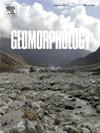Source-to-sink patterns of grain size along the Yamuna River in the Indian Himalaya
IF 3.1
2区 地球科学
Q2 GEOGRAPHY, PHYSICAL
引用次数: 0
Abstract
Material supply, water transport, and river engineering structures such as dams and barrages potentially disrupt and alter the downstream grain size pattern in a coarse-grained stream. Here, we document such complex interactions for a 70 km-long stretch of the Yamuna River and its tributaries in the western Indian Himalaya, where we quantify the downstream pattern of grain size. We particularly illustrate the grain size pattern changes in response to the hillslope-derived material supply to the stream path, and evaluate how such patterns evolve as the stream crosses a tectonically active mountain belt and finally enters a foreland basin. We also look into whether anthropogenic constructions like dams and barrages disrupt the source-to-sink sediment cascade in this stream. Grain size was measured on digital images taken at 18 locations on the gravel bars > 1000 m2 with an uncrewed aerial vehicle (UAV), and the data was supplemented with previously published datasets. The results show that the material is at its coarsest and characterized by a large intra-bar variability of grain size (poorer sorting) where the river crosses the deeply dissected mountainous terrain. This suggests a supply control on the grain size distribution where material supply by hillslope processes in a steep terrain imprints the size and the sorting of the material in the channel. Such a supply control is also inferred along the Yamuna River reach across the smooth landscapes of the Dehradun valley, which hosts the terrace sequences deposited by the Yamuna River and its tributaries during the Pleistocene, and which is currently dissected. Erosional recycling of these terrace sediments may explain why, across the Dehradun valley, the grains in the Yamuna River are nearly uniform in size. As the Yamuna River enters the Ganga foreland basin that experiences active subsidence, the material becomes finer-grained and better sorted (low intra-bar variability of grain size). The stream finally transitions from a pebbly to a sandy stream c. 40 km downstream of the orogenic front. We interpret this downstream fining trend in the Ganga foreland basin as a result of the selective deposition of the coarser-grained fraction of the bedload material, driven by the formation of accommodation space in the subsiding foreland basin. We finally found that the impact of engineering structures, including barrages and dams, on grain size is limited. Overall, this investigation demonstrates that the particle size distributions in this coarse-grained stream represent a complex system of supply and sedimentation controls, with no discernible impact from anthropogenic structures on grain size.

印度喜马拉雅亚穆纳河流域的源-汇粒度模式
物料供应、水运和河流工程结构(如水坝和拦河坝)可能会破坏和改变粗粒度河流的下游粒度模式。在这里,我们记录了印度喜马拉雅西部的亚穆纳河及其支流长达70公里的复杂相互作用,在那里我们量化了下游的颗粒大小模式。我们特别说明了颗粒大小模式的变化,以响应山坡来源的物质供应到河流路径,并评估了这种模式是如何演变的,当河流穿过一个构造活跃的山带,最终进入一个前陆盆地。我们还研究了水坝和拦河坝等人为建筑是否会破坏这条河流中从源到汇的沉积物级联。在沙砾坝的18个位置拍摄的数字图像测量了颗粒的大小。使用一架无人驾驶飞行器(UAV),面积为1000平方米,并用先前发布的数据集补充数据。结果表明,在河流穿过深度解剖的山地地形时,材料处于最粗糙的状态,其特征是粒度在沙洲内具有较大的变异性(分选较差)。这表明了对粒度分布的供应控制,在陡峭地形中由山坡过程提供的物质影响了通道中物质的大小和分选。这种供应控制也被推断为沿着亚穆纳河到达Dehradun山谷的平滑景观,该山谷拥有更新世期间亚穆纳河及其支流沉积的阶地序列,目前正在解剖。这些阶地沉积物的侵蚀再循环可以解释为什么在德拉敦河谷,亚穆纳河中的颗粒大小几乎是一致的。随着亚穆纳河进入经历主动沉降的恒河前陆盆地,物质变得粒度更细,分选效果更好(坝内粒度变动性较低)。在造山带前缘下游约40公里处,这条河最终由卵石流转变为砂流。我们将恒河前陆盆地的这种下游细化趋势解释为在沉降的前陆盆地中形成可调节空间的驱动下,粗粒级的层质物质选择性沉积的结果。我们最终发现工程结构,包括拦河坝和水坝,对粒度的影响是有限的。总体而言,本研究表明,该粗粒度河流的粒度分布代表了一个复杂的供应和沉积控制系统,没有明显的人为结构对粒度的影响。
本文章由计算机程序翻译,如有差异,请以英文原文为准。
求助全文
约1分钟内获得全文
求助全文
来源期刊

Geomorphology
地学-地球科学综合
CiteScore
8.00
自引率
10.30%
发文量
309
审稿时长
3.4 months
期刊介绍:
Our journal''s scope includes geomorphic themes of: tectonics and regional structure; glacial processes and landforms; fluvial sequences, Quaternary environmental change and dating; fluvial processes and landforms; mass movement, slopes and periglacial processes; hillslopes and soil erosion; weathering, karst and soils; aeolian processes and landforms, coastal dunes and arid environments; coastal and marine processes, estuaries and lakes; modelling, theoretical and quantitative geomorphology; DEM, GIS and remote sensing methods and applications; hazards, applied and planetary geomorphology; and volcanics.
 求助内容:
求助内容: 应助结果提醒方式:
应助结果提醒方式:


